仅供学习、参考使用
一、遗传算法简介
遗传算法(Genetic Algorithm, GA)是机器学习领域中常见的一类算法,其基本思想可以用下述流程图简要表示:
(图参考论文:Optimization of Worker Scheduling at Logistics
Depots Using GeneticAlgorithms and Simulated
Annealing)
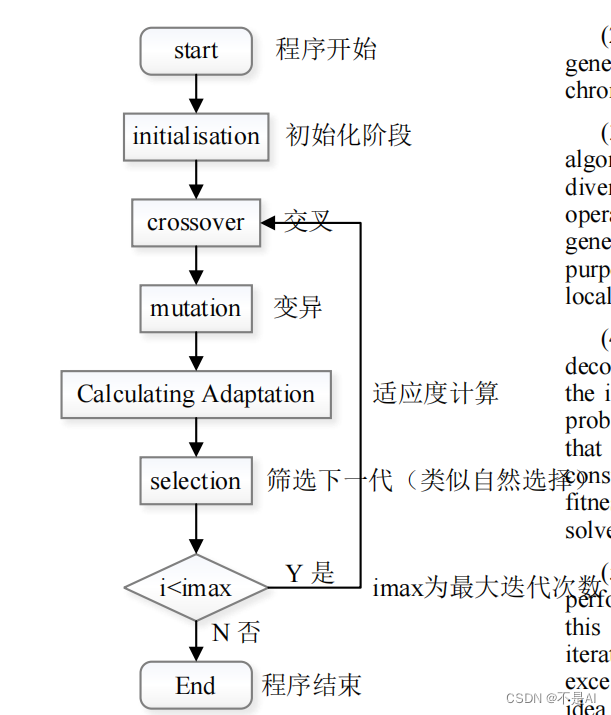
一种常见的遗传算法变例是有偏随机密匙遗传算法 (BRKGA: Biased Random Key Genetic Algorithm) ,参考论文:A BIASED RANDOM-KEY GENETIC ALGORITHM WITH VARIABLE MUTANTS TO
SOLVE A VEHICLE ROUTING PROBLEM,算法流程大致如下:
(图参考博客:Pymoo学习 (11):有偏随机密匙遗传算法 (BRKGA: Biased Random Key Genetic Algorithm) 的使用)
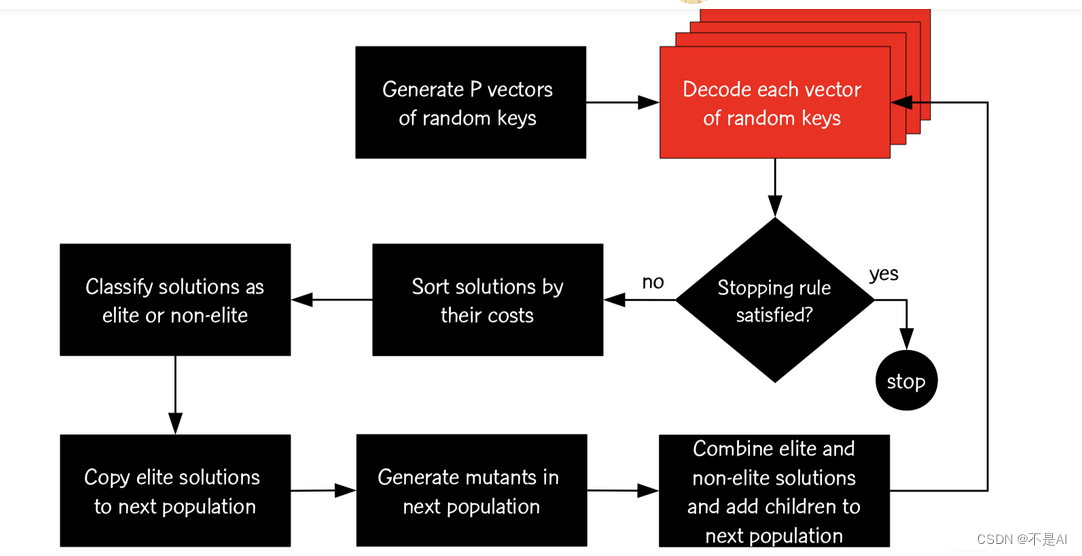
二、项目源码(待进一步完善)
1、导入相关库
import csv
import random
import numpy as np
import pandas as pd
from datetime import datetime
import matplotlib.pyplot as plt
2、药品统计
# 统计zone_id=2110的药品
def screen_goods_id(tote_data, zone):
zone_goods_id_lists = []
for i in range(len(tote_data)):
zone_id = tote_data['区段ID'][i]
goods_id = tote_data['产品编号'][i]
if zone_id == zone:
zone_goods_id_lists.append(goods_id)
zone_goods_id_lists = list(set(zone_goods_id_lists))
return zone_goods_id_lists
3、货位统计
# 统计zone_id=2110的货位
def generate_locations():
index_id_0 = [2173, 2174, 2175, 2176, 2177, 2178, 2179, 2180, 2181]
index_id_1 = [1, 2, 3, 4, 5, 6, 7, 8]
index_id_2 = [21, 22, 23, 24, 25, 31, 32, 33, 34, 35, 41, 42, 43, 44, 45]
location_id_data = [f"{aa:04d}{bb:02d}{cc:02d}1" for aa in index_id_0 for bb in index_id_1 for cc in index_id_2]
return location_id_data
4、缺失货位统计
# 统计zone_id=2110的缺失货位
def del_locations():
index_id_0 = [217408, 217507, 217708, 217807, 218008, 218107]
index_id_1 = [22, 23, 24, 25, 32, 33, 34, 35, 42, 43, 44, 45]
del_loc_data = [f"{aa:06d}{bb:02d}1" for aa in index_id_0 for bb in index_id_1]
return del_loc_data
5、生成可使用货位
# 去除缺失货位,生成最终的可使用货位
def screen_location_id():
location_id_data = generate_locations()
del_loc_data = del_locations()
location_id_lists = [loc_id for loc_id in location_id_data if loc_id not in del_loc_data]
return location_id_lists
6、个体(单个基因型)生成
# 生成一个个体
def pop_one_combined(list_1, list_2): # list1的长度不能大于list2
goods_ids_copy = list_1[:]
location_ids_copy = list_2[:]
combined_list = []
for _ in range(len(list_1)):
element = random.choice(location_ids_copy)
location_ids_copy.remove(element)
combined_list.append(element)
return combined_list
生成测试:大小为6的一维数组,生成50个个体(种群类似):
list1 = [1, 2, 3, 4, 5, 6]
list2 = [1, 2, 3, 4, 5, 6]
# 个体生成测试(批量生成)
for i in range(50):
print(pop_one_combined(list1, list2))
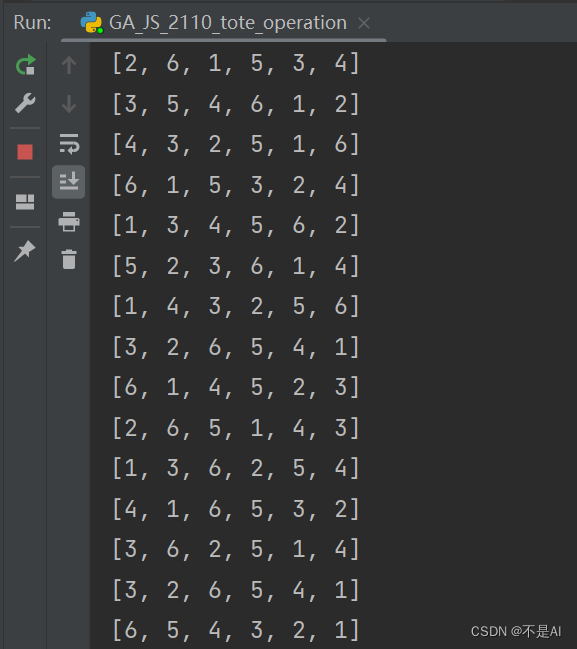
7、种群(基因池)生成
# 生成种群
def generate_pop_list(POP_SIZE, zone_goods_id_data, zone_location_id_data):
pop_list = []
for _ in range(POP_SIZE):
pop_individuality = pop_one_combined(zone_goods_id_data, zone_location_id_data)
pop_list.append(pop_individuality)
return pop_list
生成测试:
# 种群生成测试(样本量50)
print(generate_pop_list(50, list1, list2))

8、劳累值(特征系数)计算公式
# 拣选劳累值计算公式
def pick_distance_formula(location_id, shelves_num):
if location_id[-2] == '4': # 第4层(最高层)
distance = 10 * (int(location_id[0:4]) - 2173) + (shelves_num - 1) * 10 + int(location_id[-3]) + 3
else: # 第1~3层
distance = 10 * (int(location_id[0:4]) - 2173) + (shelves_num - 1) * 10 + int(location_id[-3])
return distance
9、一组数据的劳累值计算
# 拣选劳累值计算(一组)
def pick_distance_value(location_id):
distance = 0
shelves_num = int(location_id[4:6])
group_1 = [1, 3, 5, 7]
group_2 = [2, 4, 6, 8]
if shelves_num in group_1:
shelves_num = shelves_num // 2 + 1
elif shelves_num in group_2:
shelves_num = shelves_num // 2
distance = pick_distance_formula(location_id, shelves_num)
return distance
10、选择优势个体进入下一代
# 选择优胜个体
def select(pop_list, CROSS_RATE, POP_SIZE):
index = int(CROSS_RATE * POP_SIZE) # 一轮筛选后的样本数量
return pop_list[0:index] # 返回前xxx个优胜个体
11、遗传变异机制
# 遗传变异
def mutation(MUTA_RATE, child, zone_goods_id_data, zone_location_id_data):
if np.random.rand() < MUTA_RATE:
mutation_list = [loc_id for loc_id in zone_location_id_data if loc_id not in child]
num = np.random.randint(1, int(len(zone_goods_id_data) * MUTA_RATE))
for _ in range(num):
index = np.random.randint(0, len(zone_goods_id_data))
mutation_list.append(child[index])
loc_id = random.choice(mutation_list)
child[index] = loc_id
return child
12、子代中0值的替换
# (子代)0值的替换
def obx_count_run(child, parent):
for parent_elemental in parent:
if parent_elemental not in child:
for i in range(len(child)):
if child[i] == 0:
child[i] = parent_elemental
break
return child
13、基于顺序的交叉方式(Order-Based Crossover, OBX)
# 遗传交叉(交叉算子:基于顺序的交叉(Order-Based Crossover,OBX))
def crossmuta(pop_list, POP_SIZE, MUTA_RATE, zone_goods_id_data, zone_location_id_data):
pop_new = []
for i in range(len(pop_list)):
pop_new.append(pop_list[i][1:])
while len(pop_new) < POP_SIZE:
parent_1 = random.choice(pop_list)[1:]
parent_2 = random.choice(pop_list)[1:]
while parent_1 == parent_2:
parent_2 = random.choice(pop_list)[1:]
child_1 = [0 for _ in range(len(zone_goods_id_data))]
child_2 = [0 for _ in range(len(zone_goods_id_data))]
for j in range(len(zone_goods_id_data)):
genetic_whether = np.random.choice([0, 1])
if genetic_whether == 1:
child_1[j] = parent_1[j]
child_2[j] = parent_2[j]
if (child_1 == parent_1) or (child_2 == parent_2):
continue
child_1 = obx_count_run(child_1, parent_2)
child_1 = mutation(MUTA_RATE, child_1, zone_goods_id_data, zone_location_id_data)
child_2 = obx_count_run(child_2, parent_1)
child_2 = mutation(MUTA_RATE, child_2, zone_goods_id_data, zone_location_id_data)
pop_new.append(child_1)
pop_new.append(child_2)
return pop_new
14、损失曲线图绘制
# 每轮总拣选劳累值绘制曲线图
def loss_chart(data):
y_values = data
x_values = list(range(len(y_values)))
plt.plot(x_values, y_values)
plt.title("zone_2110_pick_distance_loss")
plt.xlabel("Iterations") # 迭代次数
plt.ylabel("zone_2110_pick_distance") # 距离
plt.grid()
plt.savefig('./JS_zone_2110_pick_distance_loss.png')
plt.show()
15、结果合成
# 最终结果合成
def goods_location_data_consolidation(zone_goods_id_data, zone_goods_location_id_data):
goods_location_data = []
for i in range(len(zone_goods_id_data)):
goods_location_data.append([zone_goods_id_data[i], zone_goods_location_id_data[i]])
return goods_location_data
主函数及运行:
def main():
list1 = [1, 2, 3, 4, 5, 6]
list2 = [1, 2, 3, 4, 5, 6]
# 个体生成测试(批量生成)
for i in range(50):
print(pop_one_combined(list1, list2))
# 种群生成测试(样本量50)
print(generate_pop_list(50, list1, list2))
print("Genetic algorithm run start")
print(f"start_time --> {datetime.now()}")
zone_2110_pick_distance = []
tote_goods_data_2403 = pd.read_csv('./tote_goods_data_2024_03.csv') # 读取数据集
POP_SIZE = 20 # 种群大小
CROSS_RATE = 0.9 # 交叉率
MUTA_RATE = 0.05 # 变异率
Iterations = 10 # 迭代次数
zone_2110_goods_id_lists = screen_goods_id(tote_goods_data_2403, 2110)
zone_2110_location_id_lists = screen_location_id()
POP = generate_pop_list(POP_SIZE, zone_2110_goods_id_lists, zone_2110_location_id_lists)
for i in range(Iterations):
POP = getfitness(POP, 2110, tote_goods_data_2403, zone_2110_goods_id_lists)
POP = select(POP, CROSS_RATE, POP_SIZE)
zone_2110_pick_distance.append(POP[0][0])
POP = crossmuta(POP, POP_SIZE, MUTA_RATE, zone_2110_goods_id_lists, zone_2110_location_id_lists)
loss_chart(zone_2110_pick_distance)
Updated_goods_location_data = goods_location_data_consolidation(zone_2110_goods_id_lists, POP[0])
with open('./zone_2110_goods_location_data.csv', 'w', newline='') as csvfile:
writer = csv.writer(csvfile)
writer.writerow(['goods_id', 'location_id'])
for row in Updated_goods_location_data:
writer.writerow(row)
print(f"end_time --> {datetime.now()}")
print("Genetic algorithm run end")
if __name__ == "__main__":
main()
三、算法测试
1、pop_size=20, iterations=10
cross_rate=0.5, muta_rate=0.05:
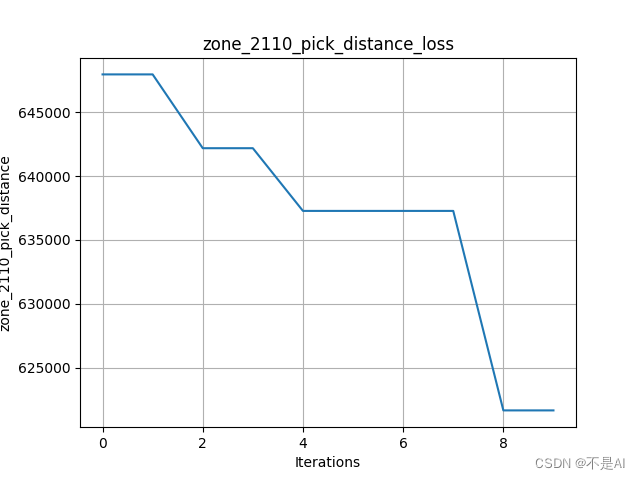
交叉率不变,增加变异率到0.1:

交叉率不变,增加变异率到0.2:
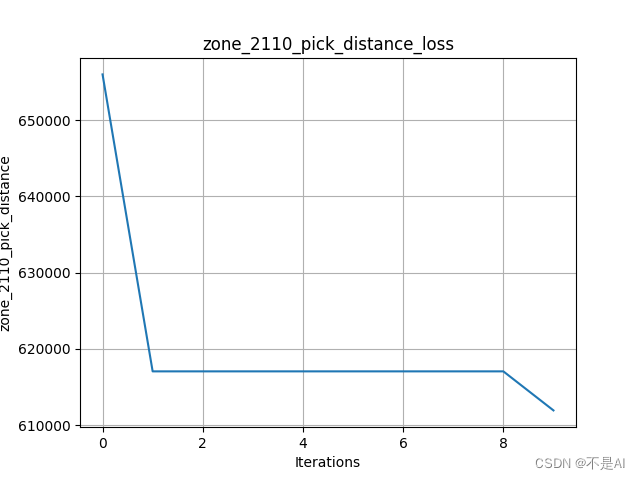
变异率不变,增加交叉率到0.9:
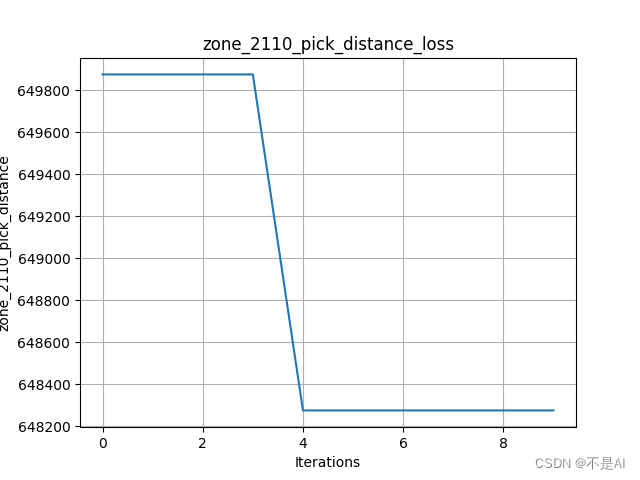
2、在另一个数据集上进行测试
采用初始参数设定:

交叉率提高至0.9:
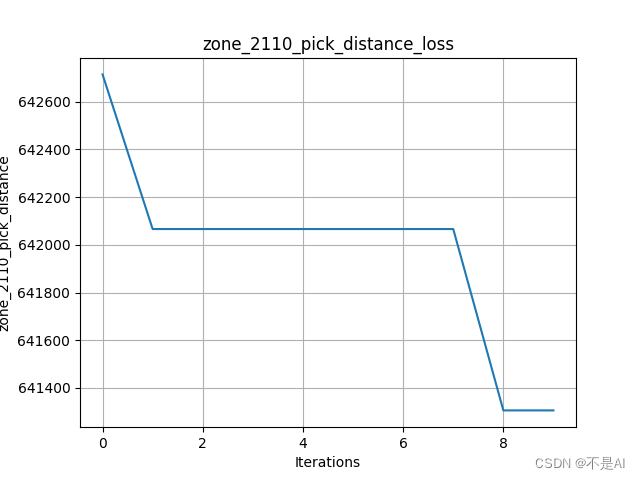
四、算法优化
GA(遗传)算法优化可行性分析
一、优化算法核心步骤参数
GA(Genetic Algorithm,遗传算法)的主要流程可以用下图进行简要描述:
在初始化阶段,需要确定imax(最大迭代次数)的值用于主循环的迭代。除这个值外,在算法的“交叉”步骤中,需要确定交叉方法(常用的交叉方法包括单点交叉、两点交叉、多点交叉、部分匹配交叉、均匀交叉、顺序交叉、基于位置的交叉、基于顺序的交叉、循环交叉、子路径交换交叉等),并指定参数cross_rate(交叉率)的值;在“变异”步骤中,需要指定参数muta_rate(变异率)的值;在“适应度计算”步骤中,需要自定义适应度(fitness)计算公式。故而可以进行优化的参数包括:
(1)最大迭代次数;
(2)交叉方法;(待验证)
(3)交叉率;
(4)变异率;(结论:提高变异率可以显著提高损失函数的收敛速度)
(5)适应度计算公式(涉及到按比例缩放的问题)。可能的策略:使用二次或者高次函数?如何提高损失函数的收敛速度?
二、采用GA的常见变式
上述流程图为GA的最基本的形式(基础GA),常见的优化变式包括:
(1)GA+SA——遗传算法结合模拟退火(Simulated Annealing)算法;
见论文:《Optimization of Worker Scheduling at Logistics
Depots Using Genetic Algorithms and Simulated
Annealing》
(2)AQDE(Adaptive Quantum Differential Evolution)算法(适应性量子差分进化算法);
见论文:《Z. Sun, Z. Tian, X. Xie, Z. Sun, X. Zhang, and G. Gong, “An metacognitive based logistics human resource modeling and optimal
scheduling,”》
(3)BRKGA(Biased Random-Key Genetic Algorithm)算法(有偏随机密钥遗传算法);
见论文:《A Biased Random-Key Genetic Algorithm With Variable Mutants To Solve a Vehicle Routing Problem》
三、结合深度学习或者强化学习
todo
四、其他可行方法
其他可行方法主要包括:
(1)向量化(vectorization);
(2)多线程(multithreading);
(3)并行计算(multiprocessing);
(4)带缓存的多级计算(cached computation)。
并行计算方面,可以使用Python中的joblib库:


























 474
474











 被折叠的 条评论
为什么被折叠?
被折叠的 条评论
为什么被折叠?










